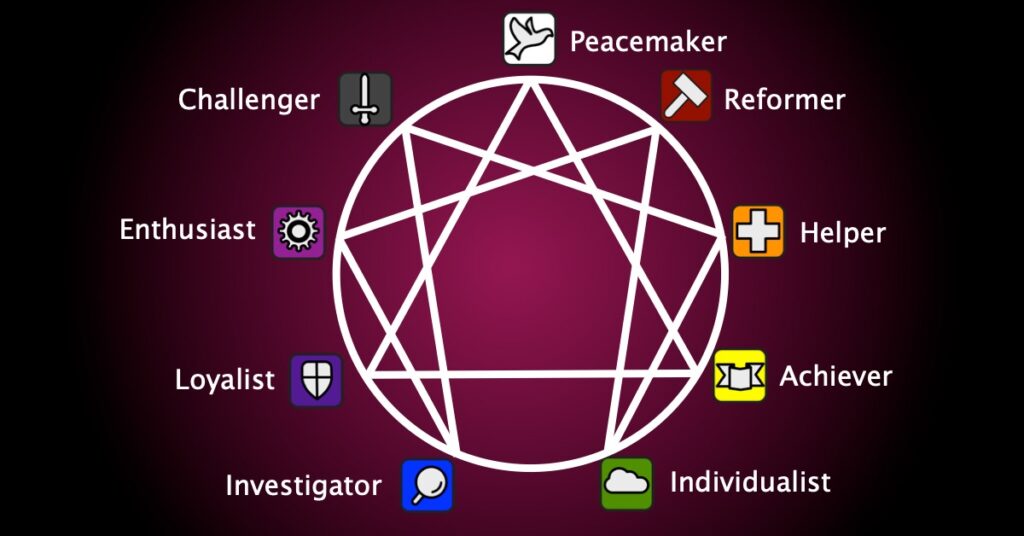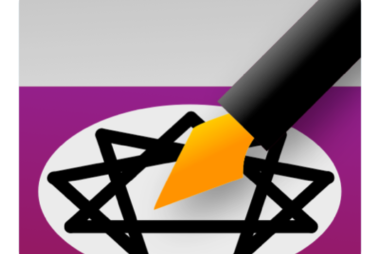
The Enneagram is a great tool for writers to have in their toolkit.
It can help create a balanced and diverse cast of characters, and it can help create main characters who are complex and contradictory, yet consistent. In other words: characters that seem real. And isn’t that always the hardest part about creating characters? Because the Enneagram is based on human behavioural types, it can do just that.
So, first things first…
What is the Enneagram?
The Enneagram is a model of human psyche that divides people into nine personality types. These types have names like “Reformers”, “Helpers”,”Achievers” and they describe a set of traits and beliefs that are common to people that fall into those types.
The Enneagram then describes a number of aspects of personality – a mixture of behaviours and beliefs such as a “vice” or “virtue”, a “great fear” or “great desire”, a “temptation” they fall back on under stress that are common to that type, and identifying the characteristic of each personality type in that particular mode of behaviour or belief. For example, a “Reformer’s” Great Desire is to be seen as doing good, a “Peacemaker’s” vice is to be lazy or disengaged. There are also two fairly idealistic traits common to each personality type: the “Holy Idea” (basically the noble idea the character is obsessed about in the back of their mind) and their “Ego Fixation” (the selfish, childish obsession they carry with them everywhere).
In a series of upcoming posts will I outline each personality type in detail but for the time being detailed descriptions are fully available in the Enneagram for Writers app, and a breif summary of the types and behaviours is at the bottom of this post

The beauty of the Enneagram is that each personality type has a common thread running through their psyche, which determines both their good and bad qualities. That makes sense in the real world. If we’re obsessed about doing things right (as the Reformer is) that can make us idealistic, a do-gooder, but also just as often angry and resentful or a hypocrite – in the same day, the same breath even.
Complex and contradictory. But consistent.
How the Enneagram helps with designing well-rounded characters.
Each of us is a tangle of conflicting, well-intentioned motivations. Sometimes we’re good, sometimes we’re bad. Sometimes we’re selfish, sometimes we’re thoughtful.
Usually we’re all of these things in the pursuit of one goal, buried deep in our psyche. We want to be loved, we want to fix the world, we want to be original. We may not like it but it colours everything we do.
Your characters should be the same. That’s why the Enneagram is so helpful.
By assigning a single personality type to our characters we get a consistent set of positive and negative behaviours to play with. We can make fairly good guesses about what they might do in any given situation. And this is fundamentally what defines a character.
Characters are what they do. You will hear it time and again on your journey as a writer. And it’s completely true. What a character wears, how they talk, what car they drive are all completely irrelevant because that stuff is only first impression – it’s a cover of a book – designed to lure us into thinking one thing or another. But its only as we watch the character in action, how they treat others, what they do in a tight situation, that we judge them. And believe me, the audience is there to judge. It’s what we’ve paid money for.
By assigning an Enneagram type to the charatcer you are instantly presented with at least seven different mode of behaviours that the audience will completely buy into – will completely “get”. And, a whole spectrum of emotions and states to take your character to – each time painting a more human figure.
The Enneagram really is a key to unlocking your character’s psyche. And if you need a backstory, ask yourself what it was that sent your character down this particular path….
How the Enneagram helps with cast design
The Enneagram is also a very helpful tool for designing your cast.
In every story there are usually one or two main characters, and a set of supporting characters. If you are using the Enneagram, it can be a good idea to assign (different) Enneagram personality types to every one of your characters.
Why? Here are five good reasons:
- Secondary characters that feel rounded and fleshed out offer the audience delightful hints of a world beyond the one they are seeing. It’s a real treat to feel there’s more to this story than just the one being presented
- If you use the full range of personality types you will find a range of different characters and you won’t simply be “writing yourself’ into every other role.
- Secondary characters suddenly can present unexpected opportunities. They start to tell you how they want to behave and this can inspire unexpected twists and turns.
- Your main characters are often defined by how they’re different from another character. They use anger while another character uses negotiation, for example. Such differences serve to emphasise a particular trait. Repeat these glaring differences to really hammer a character trait home (so again your main character resorts to anger while another character uses mere assertion etc)
Conclusion
The Enneagram is a very simple and very handy shortcut to a whole cast of consistent, yet complex and contradictory characters.
Exercises to try out
- Work out what type your main character is likely to be based on what you need them to do.
- Try changing their type to see if it alters how they might tackle the problem
- What happens if your main antagonist is the same personality type as the protagonist?
- Try to work out what type you are. Your close friends and family. Does it change how you see their behaviour? Does it help you recognise when you are just “writing yourself”?
- Start with a character type and zero in on a particular trait… What is the story that emerges from putting that character in a particular situation?
Extra: The Enneagram Types

- The Reformer – who believes in change and wants things to be better – in many ways an idealistThe Helper – who believes in love and understanding – their role is to make the world a better place.
- The Achiever – who craves recognition and success and isn’t afraid of working – and fighting – hard for it
- The Individualist – who craves to be different and creative and special – often dreamy, artistic and disconnected
- The Investigator – a cerebral type who believes the world is one of truth and deceit – it is their job to make sense of it.
- The Enthusiast – who believes life is an adventure to be seized by both hands – who rejects the mundane
- The Loyalist – who believes firmly in the commitment to an ideal or institution – who requires solidity and continuity in life
- The Challenger – who craves security and seeks to vanquish threats – someone who will take arms for their cause.
- The Peacemaker – who craves harmony and consensus – who is diplomatic and a mediator.
Enneagram Traits:
- Holy Idea – this is an idea that the type holds as some kind of greater goal – for example, The Reformer seeks perfection in things. They are idealists – perfectionists
- Ego Fixation – this is what the type tends to fixate on when they’re at their most inward-looking – the opposite of their Holy Idea. For the loyalist that might manifest as Cowardice. They fear change.
- Basic Fear – this is the thing that terrifies the type – an inner trait that they subconsciously avoid at all costs. For a Helper, this is the sense of being unworthy of someone’s love.
- Basic Desire – another basic trait that encapsulates their heart’s desire – the sort of feeling or experience they subconsciously crave. For the Enthusiast that’s the joy of the experience of life.
- Temptation – this is the character’s weakness – how they behave when they let their personality traits get the better of them. Challengers are tempted to reject others in pursuit of self-sufficiency
- Vice – this is an outward manifestation of their personality. A physical desire they revert to. For Individualists, this can be jealousy. Being envious of others success.
- Virtue – this is a commendable trait that the character displays when they’re at their very best. For Investigators, this can be a cool detachment that gives them tremendous insight.
The Ennagram for Writers gives a full breakdown of each of these traits for each of these characters.